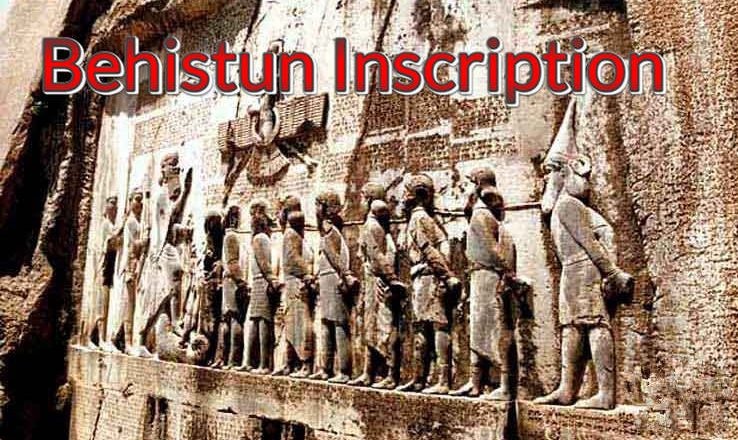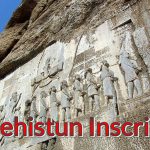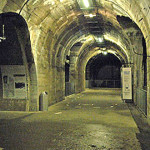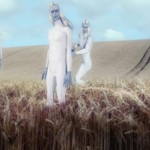Twenty kilometers to the west of Kermanshah Province in western Iran, there is a mountain called Behistun. Perched on a cliff face, there is a massive relief sculpture that stands over 60 meters above the ground. It features an enigmatic set of stone carvings, with a row of people seemingly worshiping a venerable figure with great reverence. Behind the venerable figure, there are attendants holding bows and swords. Above them is a depiction of a mysterious and magical symbol. The cliff is meticulously inscribed with rows of what appear to be a mix of writing and symbols, resembling a “heavenly script.” Why was this “heavenly script” carved high on the mountainside? What does it depict? Who are the figures, and what do the symbols mean? What message does it convey? This is the famous Behistun Inscription.
Subsequently, through research, it was revealed that the long-bearded figure wearing a crown, draped in a robe, and holding a long bow is Darius the Great, the ruler of the Achaemenid Empire. He is depicted stepping on the chest of a captive. Behind him are two armed attendants with bows and swords. The ten individuals standing in front of him are bound and appear to be captives. The symbol above the king represents a divine image. This is a realistic carving from the time of Darius the Great of the ancient Persian Empire.
Deciphering Cuneiform: Rawlinson’s Journey into Persian Cuneiform
In 1835, Rawlinson was sent to Persia as a military advisor. Despite being a military officer, he possessed a wealth of knowledge, having studied the history and literature of ancient Greece and Rome, and he had self-learned the Persian language. He had a deep interest in the cuneiform script of ancient Persia. Prior to Rawlinson, the Behistun Inscription had been discovered but remained unstudied due to the difficulty of reaching it. Rawlinson was an accomplished rock climber, and he risked his life to climb the cliffs and make rubbings of the “heavenly script.” Eventually, he directed a local youth to painstakingly reproduce the inscribed text using an impression method similar to Chinese rubbings.
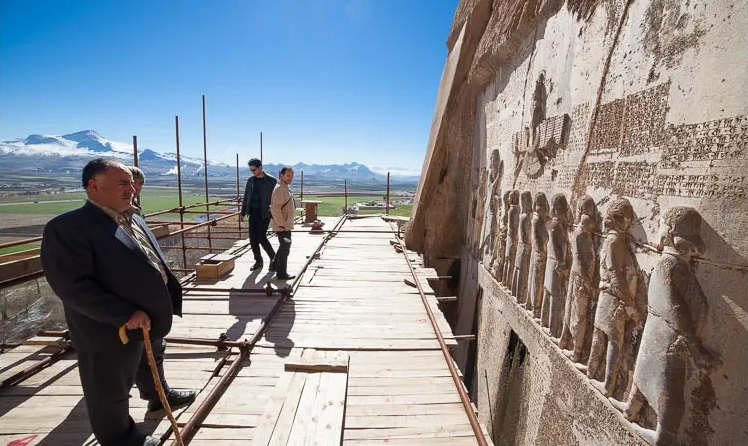
The “heavenly script” with three types of writing was finally revealed to the world. Before Rawlinson, a scholar named Pietro Valerio had diligently explored cuneiform. Valerio traveled extensively between the Tigris and Euphrates rivers, as he believed that Persian civilization originated from the two rivers’ culture. He identified Babylonian ruins and even copied five unknown scripts. Valerio’s dedication paid off. This peculiar ancient script, which had wedge-shaped characters, was named “cuneiform” because of its shape, just as Chinese characters are composed of lines. However, the combinations, variations, orientations, sizes, widths, and intricacies of cuneiform seemed both systematic and unpredictable. Valerio eventually deciphered the first step: cuneiform writing is from left to right.
Fifty years later, a British scholar, Thomas Herbert, finally delved into the idea that cuneiform was not just wedge-shaped, but also took on the form of obelisks, triangles, and pyramids, which were ingeniously combined according to a set or multiple sets of enigmatic rules to create a unique script. This linguist even published a replica of cuneiform text with three lines, and his research revealed that cuneiform was composed of words or syllables. His second discovery was that cuneiform was read from left to right and confirmed that it was the language of the ancient Persians.
After over a decade of research, Rawlinson finally deciphered the entire text of the Behistun Inscription. It was a piece intended to honor the Persian Empire and commemorate the victory of Darius the Great, the “King of Kings,” in suppressing the domestic “Gautama revolt,” thus revealing the secrets of ancient Persian cuneiform. The most challenging of the three types of cuneiform in the Behistun Inscription was one known as “Elamite,” which had over a hundred characters, signifying that it was a syllabic script.
Darius’ Victory: The Discovery and Study of the Behistun Inscription:
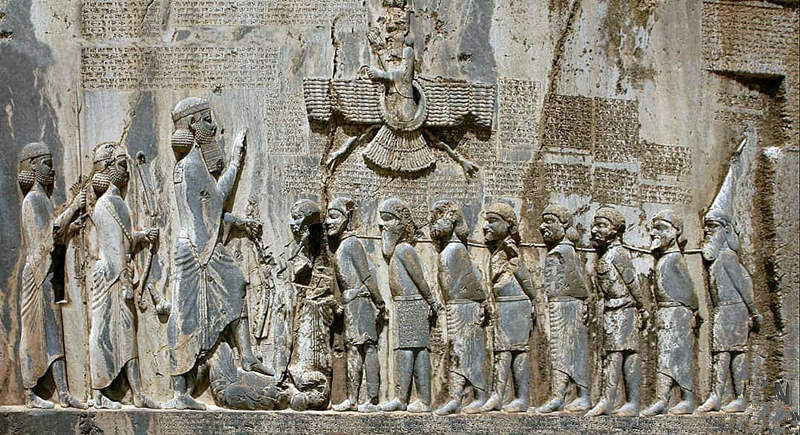
The Behistun Inscription is located on a massive rock near the village of Behistun, to the east of the modern city of Kermanshah in Iran, and stands about 100 meters above the ground. The inscription consists of three types of writing, accompanied by exquisite reliefs. In 1835, a 25-year-old British military officer named Rawlinson, guided by a local elder, came across this later astonishing inscription that would astonish the world. Rawlinson had a lifelong love for classical literature and a deep interest in various languages, later becoming a renowned linguist. The discovery excited him, and he decided to make rubbings of the inscription for careful study. However, the steep and perilous cliff made climbing difficult. Rawlinson had to use a makeshift rope ladder and, risking his life, climbed up to make rubbings. Later, he received assistance from a skilled Kurdish youth who tied ropes to the cliff and set up a basket for Rawlinson to stand in while making rubbings. In this way, Rawlinson spent over a decade in separate trips to reproduce the inscription and reliefs.
The reliefs were incredibly detailed, depicting a king with his left foot on a prostrate rebel while eight bound rebels with hands tied stood humbly before him. The king held a bow in his left hand and pointed to a protective deity in the sky with his right hand. The deity held a symbol of kingship that was about to be conferred. Later, it was revealed that the triumphant king was the renowned Persian king, Darius.
As Rawlinson made rubbings, he also studied the inscription. He initially identified the three scripts as Old Persian, Elamite, and Babylonian, all of which were ancient forms of cuneiform writing. He deciphered the Old Persian script first and learned that the inscription documented Darius’s victory in suppressing a rebellion. Rawlinson went on to identify over two hundred symbols in the Elamite script. However, the most complex and challenging was the Babylonian script, which Rawlinson tirelessly worked to decipher, collaborating with other experts in the field. Eventually, Rawlinson made a significant breakthrough in decoding the Babylonian script.
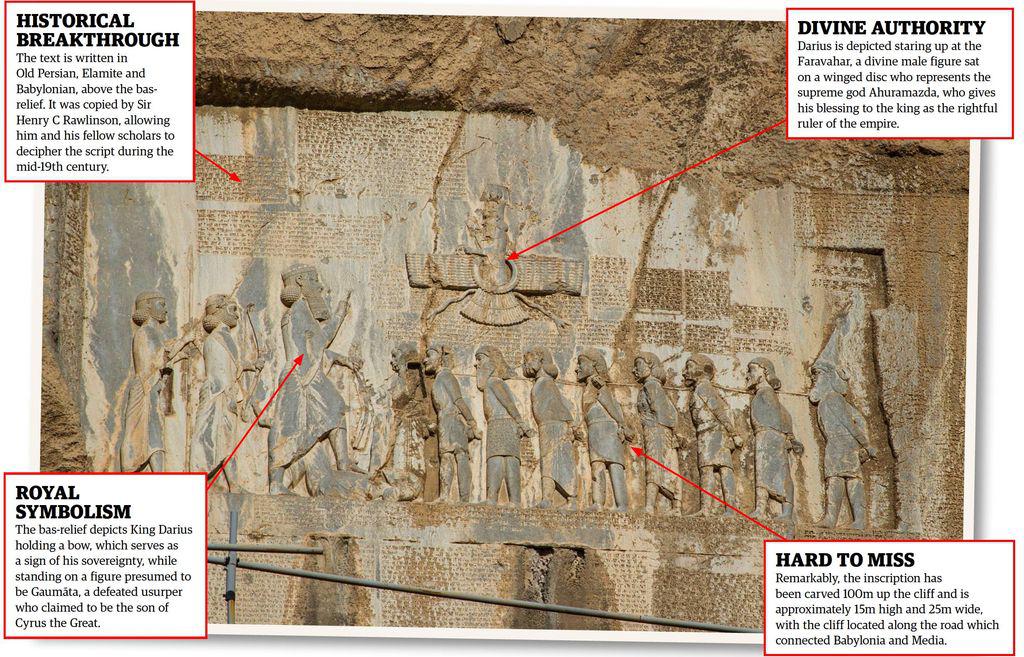
Unlocking the Persian Empire: The Valuable Research and Verification of the Behistun Inscription
To validate the research conducted by Rawlinson and others, the Royal Asiatic Society of Britain organized a special verification process. In 1857, a linguistic expert in Britain sent the results of his cuneiform script translation, related to an Assyrian king’s inscription, to the Royal Asiatic Society. The society invited Rawlinson and two other experts to independently translate the text. The four translation results were then compared and found to be almost identical. As a result, the experts concluded that Rawlinson’s method of deciphering cuneiform was correct. This marked the birth of a new field of study known as “Assyriology,” and Rawlinson was dubbed the “father of Assyriology.”
Cuneiform, which had been dormant for nearly two thousand years, was revived. The clay tablets with cuneiform inscriptions, along with numerous cuneiform inscriptions, were finally understood, unlocking various mysteries of ancient Western Asian history that had remained concealed for so long. The discovery of the Behistun Inscription made a significant contribution to human cultural heritage. Rawlinson, in recognition of his achievements, was awarded an honorary doctorate by the University of Oxford and was knighted by the Queen of England.
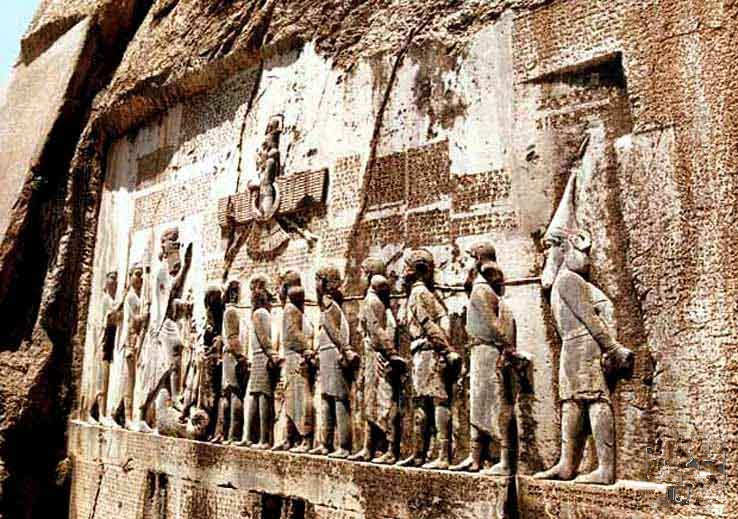
Rawlinson had previously studied the Persian language, so he focused on deciphering the inscription using the Old Persian script. With the assistance of other linguists, after 12 years of dedication, he successfully interpreted the Old Persian portion of the Behistun Inscription. The inscription roughly detailed the following:
In 522 BC, King Darius I of Persia quelled the Gautama rebellion, uniting Persia and initiating an era of territorial expansion, culminating in the Persian Empire’s zenith. The empire extended from the Indus River in the east to the Aegean Sea in the west, from Armenia in the north to Ethiopia in the south. To enhance imperial governance, the empire had four capitals: Persepolis, Ecbatana, Babylon, and Susa. Susa served as the central administrative hub, with provinces established throughout the land, and governors appointed directly by the king.
Despite Darius’s enduring contributions to the prosperity of the Persian Empire, it eventually met its end. In 330 BC, the Persian Empire was conquered by the Macedonian king, Alexander the Great. However, the glorious history of the Persian Empire was permanently etched on the Behistun Inscription for all to see.
END:
In conclusion, the discovery and deciphering of the Behistun Inscription, led by the relentless efforts of Sir Henry Rawlinson and other scholars, have unveiled a treasure trove of historical and linguistic knowledge. This ancient rock inscription, perched high on the cliffs of Behistun, has allowed us to transcend the boundaries of time and culture, offering a glimpse into the remarkable achievements of King Darius I and the grandeur of the Persian Empire.
The Behistun Inscription serves as a testament to the resilience of human curiosity and the power of perseverance in the face of daunting challenges. It has given us a deeper understanding of the rich history of ancient Persia, revealing a civilization that once stretched from the banks of the Indus to the shores of the Aegean. Rawlinson’s pioneering work, combined with the collective efforts of scholars, has set the stage for the study of cuneiform and Assyriology, enriching our knowledge of the past and bridging the gap between ancient and modern civilizations.
As we look to the future, the Behistun Inscription remains a source of intrigue and potential discovery. With ongoing advancements in technology and the continued dedication of scholars, it is possible that new insights and interpretations may yet emerge from this ancient masterpiece. The inscription has already contributed significantly to our understanding of the ancient world, and its role in unraveling historical mysteries is far from over. The Behistun Inscription stands as a testament to the enduring human spirit of exploration and learning, and it will continue to inspire future generations of researchers and enthusiasts to unlock the secrets of the past.
More UFOs and mysterious files, please check out our YouTube channel: MysFiles
Zulu Shaman’s interview: Answers about Reptilian, Grays, and the Origin of Humanity
